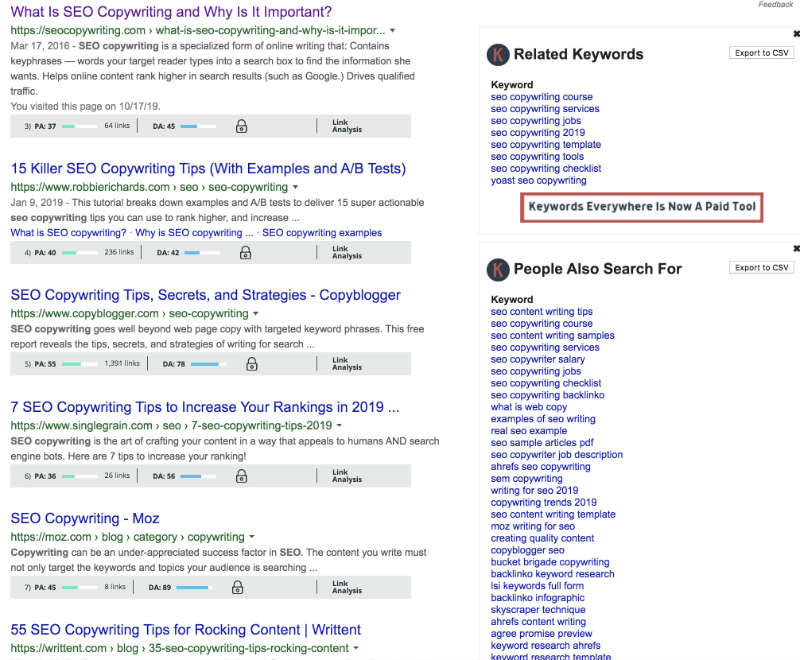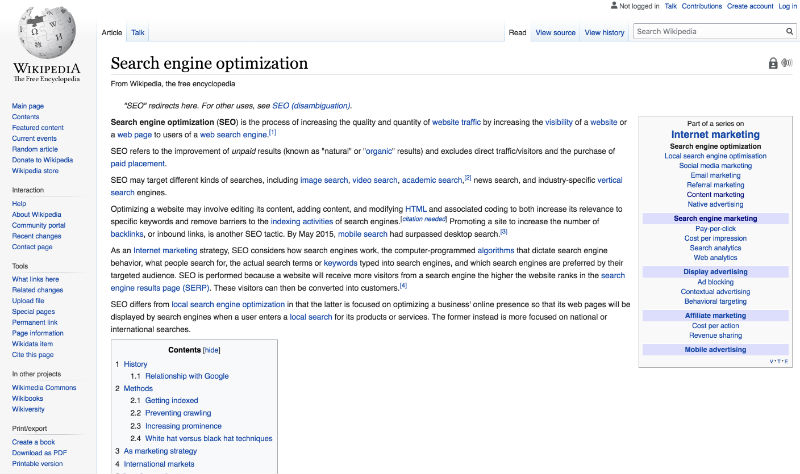01 Jan

Copywriting’s primary goal is not only to spread awareness about a certain product or service. It aims to get people to take action. Much like SEO writing, SEO copywriting also follows the same guidelines to please search engine bots.
Without adhering to SEO, copywriting is futile, making your articles invisible online. However, if you tweak your articles to make sure they’re on search engines’ good graces, you’ll get lower bounce rates and higher click rates.
That said, we’ve compiled a few SEO copywriting techniques that should keep your readers hooked and make search engine bots favor your site as well.
1. Know Your Audience

First things first, determine who your target audience is. Without knowing what makes your audience tick, you’ll never know how to communicate with them.
The way you talk to a child will never be the same as the way you speak to an adult. Knowing your audience will ensure you use the right jargon and terminologies that are well-suited for their level.
For instance, Canva, an online designing platform, creates blogs that cater to designers, business owners, or just about anyone in the creative field. Their blogs are tailored around all things design. Plus, they mostly contain high-quality images as examples.
2. Determine the Purpose of Your SEO Copy

As mentioned, SEO copywriting aims to get your target market to act. Some businesses use SEO copy to get people to:
- Visit their landing pages
- Subscribe to their newsletters
- Follow their social media networks
- Buy a product or service
Before crafting your SEO article, make sure you ask yourself a couple of questions such as:
- Why am I writing the article?
- What end goal do I want from my SEO copy?
- Which pain point am I resolving?
- What should be my blog’s primary message?
- What useful information should I include?
3. Keyword Research

Now, we direct our attention to the more technical part of SEO copywriting — using the right keywords.
Keywords are what will bring your SEO copy to success. Without them, expect your articles to be buried in the 10th or 20th page of search engines. So how will you take the first step in keyword research?
There are several ways to do this in case you’re stuck in limbo.
First of all, there are two common types of keywords in SEO: Long-tail and short-tail keywords. And as the terms suggest, long-tail keywords are usually longer keywords with more than two words.
On the other hand, short-tail keywords are vague keywords that contain only one to two words. Long-tail keywords are more specific and, therefore, have higher chances of ranking as they have lesser competition.
To start with keyword research, try using Neil Patel’s free tool to check what keywords your competitors are ranking. Or if you have short-tail keywords in mind, look for its long-tail counterparts by using the Keyword Tool’s channel.
Next is to start meddling with search engines for long-tail keywords. Try typing the keywords you want to rank in Google, and it auto-completes your query by showing some top keywords that people search for.
If you have an online store, tap into Amazon’s search box, and enter your searches there.
There are numerous browser extensions you can use to garner more keywords like the Keywords Everywhere tool. When you type a keyword, similar keywords pop up on the right side of the browser.

Or you may also scroll down to the bottom of Google’s page, and it’ll show you some similar keywords as well.
4. Take note of LSI keywords

In the past, search engines rank SEO articles via the number of times the keywords are mentioned throughout the blog. That’s why copywriters took a different route by stuffing keywords within the article that didn’t sound natural anymore.
Since Google changes its algorithms every once in a while, LSI or Latent Semantic Indexing is now a new way of ranking articles.
LSI means using similar or related keywords — in short, synonyms, so Google ranks your article.
There’s a reason why this Wikipedia article on Search Engine Optimization ranks first on Google. As you can see from the first few paragraphs, phrases like “natural traffic,” “organic traffic,” “unpaid results,” or “internet marketing” let Google know that everything is about SEO.
5. Use Bucket Brigades

When crafting your SEO copy, you want to make sure your audience read until the end. One way to do that is to use bucket brigades.
Copywriters use this article format to hook readers. By using short sentences and using phrases with colons every once in a while, readers would want to scroll down to know what the next set of information brings.
Backlinko’s blogs are a perfect example when it comes to bucket-brigade writing. This example is from one of their blogs.
The first sentence already hooks readers who want to rank their blogs. The next line that says, “In fact:” is the style that lets the readers move onto the following sentence to know what the “fact” is.
6. Make Your SEO Copy Easy to Digest

Articles with more keywords rank better on search engines. It’s simple logic:
The longer the articles, the more you can sprinkle similar keywords. But the biggest challenge when writing long-form content?
To make your audience read until the end!
That said, create a readable structure that’ll make it easy for your readers like how Wikipedia does it. Here are some things you can try for article structuring:
- Make important words and phrases bold
- Use numbers and bullets
- Create enough white space
- Include three to four sentences in each paragraph
- Use subheadings
7. Create Captivating Titles

The first step in getting your readers to click is through your title tags and meta descriptions. Make them count!
Keep them short and sweet, and make sure you include your main keywords in your title. Include enticing modifiers such as top, best, tips, simple, guidelines, “how to,” or numbers to catch your readers’ attention.
Next is to let them know what they’ll get from your article. Craft your meta description concisely. Starting with an action verb or phrase will urge readers to click.
Here’s an example from Dog Breed Info on succinct meta descriptions.
8. Include a Call to Action

SEO writing’s final nudge in making readers act is the call to action. Lead them to the bottom of the sales funnel by including tried and tested call to action words and phrases.
For instance, if you’re aiming to expand your social media following, include a call to action button right after the article. It’s the little details like this that make your SEO copy a success.
Wrap Up
Now that you know where to start on SEO copywriting, always remember to focus on quality articles. Proofread your pieces to avoid syntax, grammar, and spelling errors. A misspelling is still a no-no in article writing, and will quickly turn off your readers. Read your articles aloud and proofread more than once to make them flawless.
Leave a Comment
You must be logged in to post a comment.











Erlinda Carrillo
The self education industry is a $355 Million per day industry and is expected to TRIPLE in the next 5 years! And with the right strategy this could be your opportunity to:
Get in early before it is oversaturated.
Help others go faster while you get paid
Fix a broken system
Make an impact on the world
Get paid for a skill, hobby, passion or expertise you already have (or get paid from someone else’s)
And Tony Robbins, Russell Brunson and Dean Graziosi are finally going to show YOU how to take advantage of it…
(Now if you don’t already know who these 3 guys are then you’ll want to listen up!! They’ve impacted millions of lives and have generated billions of dollars)
Look, if you’ve ever thought about (or even if you never thought about) getting paid for something you know (like a passion or a skill)… or even getting paid from what others know, then you have to attend.
This is one of the fastest growing industries online and in all areas of the world.
And for the first time ever they’re doing a webclass training on how to extract your wisdom (or somebody else’s) and get other people to pay you for it!
You can save your spot here (and when you do register, you’re immediately going to get a brand new, never before seen training from Tony and Dean. No one else will ever get a chance to see this rare training except for us).
kbbmint.com
After hearing what they’re teaching, I truly believe this is the #1 way to make a massive income, make a massive impact on the world and leave a legacy!
And here’s just a fraction of what you’ll learn this week:
The mostly hidden $129 Billion dollar market and how you can make a massive impact and leave a legacy by profiting from it.
The KBB Triangle: The 3 ways to profit (whether you’re an expert with a thriving business, just getting started, or even if you’re at complete rock bottom)
The framework to profit from what you (or someone else) already knows – or by creating community and bringing people together.
Plus you’ll even be able to ask them questions when they do Q&A at the end of the training. (Chat is limited so show up early).
There’s no other time where you’re going to have this opportunity. So BE THERE! Because if you’re not going to make a shift in your life now, then when? And if not with these guys, then let me ask with who?
This is your rare chance to learn from 3 people who started from nothing and went on to generate billions of dollars and build massive companies.
Spots are filling up faster than they ever have, so you need to hurry and go here to save your spot
https://kbbmint.com
Register now and I’ll see you there this week – Plus they did a few brand new “pre-event” trainings that only those who register get access to.
Talk soon